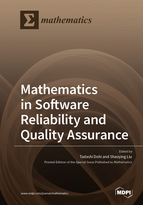Mathematics in Software Reliability and Quality Assurance
A special issue of Mathematics (ISSN 2227-7390). This special issue belongs to the section "Mathematics and Computer Science".
Deadline for manuscript submissions: closed (15 October 2021) | Viewed by 25206
Special Issue Editors
Interests: stochastic model; reliability and maintenance; performance evaluation
Special Issues, Collections and Topics in MDPI journals
Special Issue Information
Dear Colleagues,
It is well known that every complex system is controlled by software. However, it has been still a challenging issue to develop fault-free software in industry, because it is almost impossible to guarantee/prove that software systems under consideration are fault-free in advance. In this sense, software reliability and quality assurance play a central role in modern software engineering/science.
This special section focuses on the mathematical aspect in software reliability and quality assurance. In the formal verification and validation, mathematical logic is frequently used. Discrete event systems, automata theory and model checking are also significant tools to perform static analysis of software. In software testing, many kinds of optimization techniques and meta-heuristics are applied to derive the feasible solutions. Software reliability, availability and safety assessment are based on stochastic processes and their statistical inference.
In this special section, we encourage to submit the latest research results on software reliability and quality assurance. The topics of interest are given in the following, but not limited to:
Formal methods and design
Automatic program generation
Automatic software testing
Software verification and validation
Program analysis and language theory
Coalgebra theory
Automata theory
Hybrid system
Software reliability modeling and assessment
Software safety
Software security
Software fault tolerance
Software dependability
Prof. Dr. Tadashi Dohi
Prof. Dr. Shaoying Liu
Guest Editors
Manuscript Submission Information
Manuscripts should be submitted online at www.mdpi.com by registering and logging in to this website. Once you are registered, click here to go to the submission form. Manuscripts can be submitted until the deadline. All submissions that pass pre-check are peer-reviewed. Accepted papers will be published continuously in the journal (as soon as accepted) and will be listed together on the special issue website. Research articles, review articles as well as short communications are invited. For planned papers, a title and short abstract (about 100 words) can be sent to the Editorial Office for announcement on this website.
Submitted manuscripts should not have been published previously, nor be under consideration for publication elsewhere (except conference proceedings papers). All manuscripts are thoroughly refereed through a single-blind peer-review process. A guide for authors and other relevant information for submission of manuscripts is available on the Instructions for Authors page. Mathematics is an international peer-reviewed open access semimonthly journal published by MDPI.
Please visit the Instructions for Authors page before submitting a manuscript. The Article Processing Charge (APC) for publication in this open access journal is 2600 CHF (Swiss Francs). Submitted papers should be well formatted and use good English. Authors may use MDPI's English editing service prior to publication or during author revisions.
Keywords
- Software reliability
- Software quality
- Software verification and validation
- Mathematical foundation of software science and engineering







